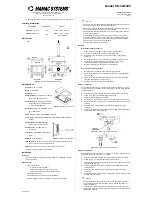
NPX138N Series Panel Mount FM Transceiver
SM41 Installation and Operation Manual
Section 3 Rev: 1.00
Issue 4
Page 3-8
3.9
Channel Editing{tc "1.4.7
Channel
Editing"}
Editing is the general term for changing any information stored in the NPX138N radio. There are two
basic types of editing, all selectable from the front panel of the radio. These are ‘Channel editing’ (
CH
)
and ‘Status editing’ (
ST
). The labels below the general controls (connected by lines) represent the
functions of those switches during editing.
As the name implies, the channel editing feature, when enabled, permits the operator to change channel
data. This data includes channel names, transmit and receive frequencies and tones, and list scan flags.
For models with synthesized guard modules (-x7x), the guard receive frequencies may be edited when
the SCAN/NORM/GD TX switch is in the GD TX position, and the radio is in the 'Channel Edit' mode.
For all other models, editing of guard receive frequencies is not possible.
Only those frequencies the radio recognizes as ‘valid’ are enterable, and only in the fractional multiples
allowed.
To edit channel information, use the
DISP
switch to select the required data line for editing (
ID
,
RX
or
TX
), and then enter ‘Channel Edit’ mode.
To enter ‘Channel Edit’ mode, pull and lock the
EDIT
switch to the left (
CH
). The position or character to
be edited will blink. This blinking character (editing cursor) indicates the data selected for editing.
SELECT (Scroll Data)
NEXT (move cursor) Channel Edit
HELP
When channel editing of data is in progress, the radio suspends normal operation and the dual function
controls work as described in the following sections.
3.9.1 SELECT
Switch
The
SELECT
switch steps the data entry up or down (
+
or
−
). The radio only permits a valid choice for
each position selected for editing. This is to aid operators in reducing entry mistakes, particularly when
busy with other flight procedures.
ENG-FORM: 806-0115.DOT
CONFIDENTIAL AND PROPRIETARY TO NORTHERN AIRBORNE TECHNOLOGY LTD.
The document reference is online, please check the correspondence between the online documentation and the printed version.










































